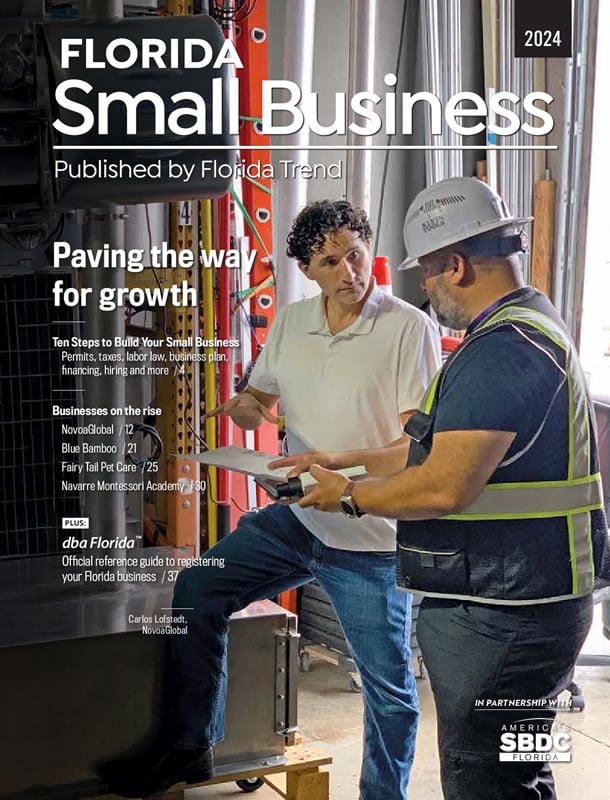March 28, 2025 | Brittney J. Miller
In 1978, following a national energy crisis, former President Jimmy Carter created the Aquatic Species Program within the U.S. Department of Energy. Its mission: develop renewable transportation fuels from algae.
Yes, you read that right — algae.
The word may summon musings of the bright green pond scum painting your local lake, or of the ecological nightmare blooms that mar Florida waterbodies most summers. But, for some hopeful scientists, public officials and industry leaders, algae represented a more sustainable and self-reliant energy source that could fuel the nation’s future.
Between 1978 and 1996, researchers within the federal Aquatic Species Program collected more than 3,000 strains of algae from across the U.S. Fifty-one of those strains, including four from Florida, were identified for their potential to create fuel. The team also proved the concept of long-term, reliable algae production in open ponds — the foundation for algae farms hoped to replace quadrillions of units of nonrenewable energy.
Flash forward decades later. Algae biofuel has ridden a roller coaster of momentum and support, handicapped by technological and economic constraints. Researchers are split on its feasibility. Many industry players — including a handful of Florida startups — have tried and failed to wield its potential. Meanwhile, nutrient pollution continues to fuel harmful algal blooms that clog our state’s waterways, disrupt ecosystems and pose threats to surrounding communities.
Despite the hurdles, algae biofuel’s promise persists — particularly in the Sunshine State, where many still hope the industry can thrive. Its commercial realization, though, remains a question mark.
The algae advantage
Let’s start from the top: Why algae?
The predominantly aquatic organisms span a diverse range of forms — from a single microscopic cell to a 150-foot-long strand of kelp swaying in ocean currents. They can sport a variety of colors, including red, brown and green.
Despite the continued occurrence of harmful algal blooms in Florida waterways, algae’s critical ecological roles can’t be understated: They mark the start of most aquatic food chains, and thanks to photosynthesis, they are estimated to produce up to 70% of the world’s oxygen. They’re also highly efficient at absorbing carbon dioxide from the atmosphere, making them prolific carbon sinks.
Algae have earned a spotlight in biofuel production because of their high production of lipids, or fats, that provide energy. (In fact, microalgae are the highest lipid-producing organisms on Earth.) Those lipids can be extracted and converted into biofuel. Algae also synthesize lots of proteins, sugars and carbohydrates, which can be used in other applications like animal feed.
The organisms are unassuming powerhouses. Most algae grow fast — much faster than other options for biomass fuel, such as trees or crops. They reproduce fast, some species doubling their population within hours at their quickest. And it takes very little land to farm algae compared to traditional crops, boosting their per-acre productivity.
Altogether, those qualities pose algae as an inherently renewable resource, says George Philippidis, associate dean of research and director of the Sustainable Energy concentration at the University of South Florida Patel College of Global Sustainability.
“We see them as a great natural resource (for) making lipids, carbohydrates and proteins, and then extracting them and turning them into products that are useful to us as human beings,” particularly biofuels, he says. “Displacing fossil-based products — that’s the idea. It’s the same quality as the fossil-fuel products, but renewable and low-carbon, so we can help the environment (and) reduce carbon emissions.”
Fourteen years ago, Florida’s ‘algae-preneurs’ were raising tens of millions of dollars from investors to create large-scale algae-to-biofuel facilities. Their plans didn’t pan out.
Across techniques, the path from algae to biofuel follows the same general method. The first step is selecting the appropriate species. Then, it’s grown in vessels and fed carbon dioxide, light and nutrients. The crop starts small, graduating from tiny flasks to bigger containers, and then eventually moving into outdoor ponds or closed photobioreactors as it grows. Eventually, the matured algae can be harvested.
Then comes the magical step of hydrothermal processing. Think of the process like pressure cooking, says Corinne Fuller, manager of bioenergy technologies programs at the Pacific Northwest National Laboratory in Washington state. The wet algae are subjected to high pressures and temperatures, which turn them into an oil called biocrude. That gets refined and upgraded to become products like jet and military fuels and biodiesel.
From start to end, the process mirrors algae’s natural life cycle — decomposing, getting buried under Earth’s crust and getting pressurized into fossil fuels over millions of years. It’s just a quicker means to that end.
The big idea? Instead of building refineries for oil, build them for algae biofuel production, Philippidis says. And, even better, make it a circular and sustainable process by feeding algae human waste streams like industrial carbon-dioxide emissions, wastewater or agricultural runoff.
“We are utilizing the output from one sector as input for another technology,” he says. “There is a great synergy there that we can exploit.”
The need for renewable fuel sources grows more dire by the year as countries and companies promise to curb their greenhouse gas emissions.
The European Union, for instance, adopted its ReFuelEU Aviation law in 2023 with the goal of decarbonizing the aviation sector. This year, all fuel at EU airports must contain at least 2% of sustainable aviation fuels, or SAFs. That share will eventually rise to 70% by 2050, forcing local and international airlines to rely more on SAFs or face fines.
Even more pressing, some say, is the need for domestic fuel security. The price and availability of fossil fuels often fluctuate with geopolitical events, motivating the search for domestic fuel sources, says Ashvini Chauhan, a Florida Agricultural and Mechanical University professor of environmental biotechnology.
He has worked on algal research projects with the U.S. Department of Defense to explore biofuel sources for military vehicles: “They want, obviously, the United States to become more self-reliant and not depend so much on fossil fuel.”
Boom — and bust
About 20 years ago, AquaFiber emerged in Central Florida. The company found its calling in water remediation, cleaning Orange County’s Lake Apopka by harvesting algae and other pollutants from its depths.
After several iterations of a business plan, AquaFiber decided to find beneficial uses for the collected algae — one of which was turning it into biofuel.
The company built mini treatment plants on the shores of Lake Apopka and Seminole County’s Lake Jesup, pumping several million gallons of water a day from the water bodies, skimming algae from it, and eventually transforming it into jet fuel. The plants could process 100 million gallons of water on 10 acres of land. (The company also created fertilizer pellets from the algae.)
AquaFiber was one of several Florida companies fixating on algae around a decade ago, driven by pushes to eliminate wild algal blooms and their rippling effects on state waterways, says Bill Eggers, the company’s vice president of science and technology.
Until it wasn’t. State and private investments shriveled when profits didn’t materialize. Facilities shuttered. Most of AquaFiber’s assets were sold off. The company is now reduced to an outdated Facebook page, last updated in 2019.
“We realized if we were going to create biofuel from algae to feed the domestic market, you would need huge amounts of algae to even make a dent in what the fossil fuel and other clean energy industries were providing,” Eggers says. “So, it didn’t really work out, necessarily, from a profit standpoint.”
Researchers have proven the science of turning algae into biofuel. The biggest limitations right now, they say, are the high costs of growing, harvesting and processing the product. The technology and necessary infrastructure are feasible but underdeveloped, leading to scalability issues.
Corinne Fuller, manager of the bioenergy technologies programs at Pacific Northwest National
Laboratory in Washington state, says that converting algae into fuel is so costly “that you might be better off making nutraceuticals and other products.”
A national algal biofuels research consortium managed to reduce the cost of algae-based biocrude from $240 to $7.50 per gallon — but that’s still not cheap enough to make it a competitive alternative energy source.
Some estimates place algal biofuel at two to three times the price of fossil fuels, depending on market prices. Even then, Fuller calls most projections “overly positive,” as they may not factor in the necessary redundancy for proper facilities. To get realistic numbers, she multiplies estimates by at least two to get the minimum fuel selling price — all but eliminating any chance of competing with existing fuel sources.
The conundrum has crippled many of Florida’s algae-to-fuel startups over the years, like Eggers’ AquaFiber, and prompted industry-wide turnover. FLORIDA TREND featured Agrisys of Orlando in a 2011 article about the burgeoning industry, along with PetroAlgae of Melbourne and Algae Aviation Fuel of Sarasota [“Florida Algae-preneurs,” January 2011]. None of the companies has a discernible presence in the business anymore.
“You don’t see any big facilities on any lakes that are staying around for a while now,” Eggers says. “It’s all of the pilot projects that spin up and spin down.”
Investments into algal biofuel have waned in general. Over the last two decades, many big oil and gas firms — including Shell and BP — have bowed out of early-day commitments to invest in algae biofuels. Most recently, Exxon- Mobil ended a 14-year partnership with California-based algae biofuel company Viridos in 2023. It had once predicted to produce 10,000 barrels of algae-based fuels a day by 2025.
Even Carter’s Aquatic Species Program eventually lost funding and disbanded in 1995. The remains of the program’s algae collection are now housed at the University of Hawaii. Less than half of the original 51 high-value strains have survived. Much of the remaining algae-related research now focuses on products that are more commercially viable, such as dietary supplements, food ingredients, pharmaceuticals and cosmetics.
“It can be so costly to grow algae and to convert it into things,” Fuller says, “that you might be better off making nutraceuticals or other products that have higher value.”
Pressure Cooker
Hydrothermal processing mimics the natural process of fossil fuel formation. Wet organic materials, like algae, are used as starting materials. They’re subjected to extreme heat and pressure that breaks down their carbon bonds. The resulting outputs span the gamut of bioproducts, which can be upgraded to refined fuels. “This accomplishes what it takes a million years for nature to do in about 30 minutes,” says Altamonte Springs City Manager Franklin Martz, who is collaborating
with infrastructure consulting firm AECOM on a biofuel project at the city’s water reclamation facility.
Turning the tide (again)
In 2016, a blue-green algae bloom swelled to coat 300 square miles of Lake Okeechobee, Florida’s largest lake. The state declared an emergency as lake discharges spread blooms into surrounding estuaries and several miles into the Atlantic Ocean.
Dan Levy, a geologist working for infrastructure consulting firm AECOM, looked to algae remediation techniques on the market. Finding few, he created his own solution: an entirely new algae practice within AECOM, which is now among Florida’s leaders in harmful algal bloom remediation.
The team is taking the practice a step further. “We can now take that (algae) and not treat it as waste,” Levy says. “We asked the more valuable question: ‘What can we do with this? What can we create with this?’”
Despite the hurdles, AECOM’s leaders believe biofuels can be part of that answer — and the firm is helping to pave a path forward for operations in Florida and beyond.
To date, the company has focused on building pilot and demonstration plants around the world. The first hydrothermal liquefaction plant will come online in Vancouver, Canada, next year. AECOM isbuilding its first full-scale algae harvester on Long Island, N.Y., and hopes to construct Florida’s first hydrothermal processing plant by 2030.
“I am confident that we will continue to expand our operations in Florida,” Levy says. “We do believe once we have (a hydrothermal plant) in our state, we can then take our food waste or seasonal algae ... and have Florida lead this for our country.”
For now, it’s partnering with the U.S. Army Corps of Engineers on a research project called Harmful Algal Bloom Interception, Treatment, and Transformation System, or HABITATS.
Since 2019, the team has focused on responding to harmful algal blooms by skimming them from the water’s surface — much like oil spill clean-up technology — and pumping them to shore. There, injected microbubbles separate the algae from the water, keeping the waste product ashore and pumping the water back into the environment. (The method also removes at least 50% of total nitrogen, 90% of total phosphorous and 90% of cyanotoxins from the water.)
The project is transitioning from the research phase to assessing potential applications — including turning the collected algae into diesel fuel via hydrothermal processing. In 2020, HABITATS conducted an onshore demonstration of the process just south of Lake Hancock near Lakeland, processing about 75 gallons of water per minute to prove its practicality.
The team has since developed a deployable system that can process up to 2 million gallons of water per day, says Martin Page, the U.S. Army Engineer Research and Development Center’s operational water research team lead. A unit is stationed in Florida for potential future work
“We don’t want (harmful algal blooms) to occur, period. ... It’s not going to be a fuel business construct by itself, nor should it be,” Page says. “However, there are significant cost savings that could occur from (algal biofuel), at scale … The resource recovery is a benefit, certainly, and from the energy side, it’s a significant benefit.”
AECOM also pairs with Central Florida’s Altamonte Springs on a biofuel project at the city’s water reclamation facility. In 2022, the team used hydrothermal processing to transform city sewage and locally harvested algae into carbon-neutral biocrude and biogas. The first phase of the pilot produced 4 to 6 gallons of crude oil a day, processing 75 gallons of wet waste in total.
Altamonte Springs was the first city in Florida and the third in the country to test the tech. The project’s second phase, starting sometime this spring, hopes to guide a scalable implementation plan for other municipalities to replicate.
“Innovation is great. Innovation is wonderful, but you have to be able to deploy it at scale. That is part of what we are going to be learning,” says Altamonte Springs City Manager Franklin Martz, adding that the city hopes to possibly monetize the process in the future. “This accomplishes what it takes a million years for nature to do in about 30 minutes.”
Researchers are still working on making the tech more feasible.
The HABITATS team, for instance, is experimenting with environmentally safe ways to float algae to the water’s surface in freshwater environments, making it easier, quicker and cheaper to skim wild algae blooms. Other scientists look to genetic engineering to enhance algae’s lipid production, making it more feasible and economical for commercializing algae farms.
If the industry does take off, Florida is positioned to be a potential hub of activity. The National Renewable Energy Laboratory has identified the Sunshine State as a top destination for algae production, thanks to its warm temperatures and humidity that boost productivity. (Fuller notes that Florida also comes with a range of risks industry members may be wary of, such as hurricanes that could damage facilities. It also lacks pipeline infrastructure to transport product.)
USF’s Philippidis is trying to team up with the private sector to address capital and operating hurdles. He’s inviting company leaders to campus, where he has managed an outdoor algae cultivation system at the USF Botanical Gardens, to showcase how different algae technologies operate and entice algae-related facilities.
The power to harness algae biofuel may lie within big companies with deep pockets to dedicate to the cause.
“If it’s a mom-and-pop shop, you usually don’t have the assets and the resources to accomplish a lot of these projects,” unlike the Fortune 500 company AECOM, Levy says. “I saw some really interesting concepts, but they were at the garage level, and they never were able to make it there to a commercial standing.”
With companies like AECOM leading the way, the tide for algal biofuels may be turning once again. Federal funding for algal biofuel research kickstarted with the American Recovery and Reinvestment Act of 2009, making up to $85 million available for the development of algae-based biofuels and other biofuels.
The legislation also provided funding for the National Advanced Biofuels Consortium and the National Alliance for Advanced Biofuels and Bioproducts. The latter, an algal biofuels research consortium created in 2010, allowed 39 industry, academia and government partners to share “best-in-class” technical approaches for developing biomass-based fuel production pathways.
Over three years, the alliance reduced the cost of algae-based biocrude from $240 to $7.50 per gallon. Most recently, in January 2023, 30 of the group’s identified best-performing algal strains were officially available in the University of Texas at Austin’s Culture Collection of Algae for easy distribution.
In the 1998 close-out report of the now-shuttered Aquatic Species Program, the foundation for much of the country’s algal biofuel research, team members were hopeful about the future of their mission: “This report should be seen not as an ending, but as a beginning. When the time is right, we fully expect to see renewed interest in algae as a source of fuels and other chemicals.”













